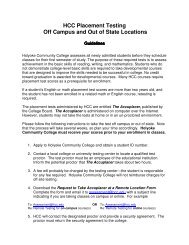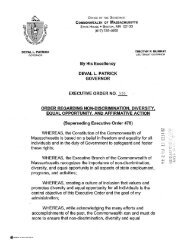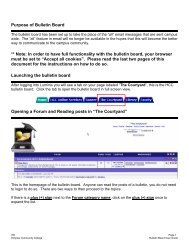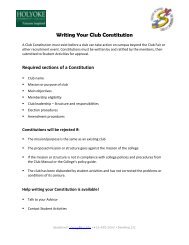the FAFSA reported on the FAFSA half-time or less-than-half-time)The following packaging policies are also followed at HCC: Grants (SEOG) are normally restricted to studentswith Expected Family Contributions (EFC) = $0 to Federal Pell Grants for private scholarships unless required by regulationAwards to students with bachelor’s degrees are limited toloans and jobs. Also, students who are simultaneouslyenrolled in high school and HCC are not eligible for anyfinancial aid.<strong>Student</strong>s enrolled in a study abroad program that has beenapproved by the college should contact the Financial AidOffice for information about financial aid eligibility for theprogram.Aid Packaging<strong>Holyoke</strong> <strong>Community</strong> <strong>College</strong> uses a form of “EQUITYPACKAGING” to award financial aid grants. Under equitypackaging, an attempt is made to cover a pre-determinedtarget amount through grant aid and the student’s expectedfamily contribution (EFC). The EFC is determined accordingto a federal formula based on the FAFSA applicationdata and is reported to the family via the resulting “<strong>Student</strong>Aid Report.” The target amount is determined by the financialaid office based on the amount of funds that are availableand the number of students who are expected to applyfor these funds.Listed below is an example of a financial aid grant packagethat would be awarded to fully eligible full-time studentswith a pre-determined target amount of $6,400 and anexpected family contribution equal to $0:22$5,550 Federal Pell Grant$200 Federal Supplemental EducationalOpportunity Grant$432 Financial Aid Tuition Waiver$218 Mass Furcolo Access GrantThe students in this example are receiving a total of $6,400in grant aid which is the target amount minus their expectedfamily contribution of $0. Since these grants exceed theamount needed for tuition, fees and books, the excess wouldbe available to help with out-of-pocket expenses such asroom and board, lunches, transportation, and daycare.Three-quarter-time and half-time students are packaged withgrants that are three-quarters and one-half of the amountspackaged for full-time students with the same EFC’s. Theirdirect costs (tuition, fees and books) are also proportional toenrollment status.If a student does not qualify for enough grant aid to coverdirect costs, educational loans are offered to cover the shortfall.A student who needs help with out-of-pocket expenses canrequest additional loan funds for these other costs. Loans ofmore than $3,000 toward out-of-pocket expenses may requireextensive loan counseling, involving the preparation of adetailed budget for the present and consideration of futureborrowing needs and employment prospects.Work-study funds are awarded to students who met thefinancial aid priority deadline, have relatively high financialneed and who indicated an interest in jobs on their FreeApplication for Federal <strong>Student</strong> Aid (FAFSA).A student’s initial financial aid eligibility for each semesteris based on the enrollment status at the end of the add/dropperiod (for summer this normally means the first add/dropperiod).The college does reserve the right to adjust awards due tochanges in students’ eligibility or the availability of funds.Financial Aid Limitations of developmental coursework (not counting ESLcourses). the student never attended. are limited to 18 full-time semesters of Pell Grant. ancewithout the student’s written permission. coursework.Timing of Financial Aid PaymentsThe first aid payment for a term normally occurs on the student’saccount around 30 days after classes start. A studentwith a credit balance resulting from aid in excess of the balancedue receives a check within 14 days of disbursement.Unearned Financial AidIf a student stops attending classes before completing 60% ofthe semester, the student is considered to have earned onlya percentage of his/her aid equal to the percentage of theterm completed. In such cases the school must apply federaland state rules to determine how much unearned aid must berepaid respectively by the student and the school. Until thestudent repays the unearned aid, he/she is considered to have
a financial aid overpayment. Federal overpayments preventa student from receiving federal or state aid at any school.State overpayments disqualify the student for state aid at anyschool. In addition, the return of aid by the college can leavean unpaid balance on the student’s college account.When calculating the unearned aid, the regulations requireschools to use the date the student begins the withdrawalprocess as the “date of withdrawal.” <strong>Holyoke</strong> <strong>Community</strong><strong>College</strong> defines the date the student begins the withdrawalprocess as the date the student obtains withdrawal formswith the intention to completely withdraw from school.If a student stops attending, and fails to officially withdrawfrom classes, the school normally uses the 50% point of theterm as the “withdrawal date,” although a different date maybe used if the school has received a last date of attendancefrom an instructor.Federal <strong>Student</strong> Financial Aid Penalties for DrugLaw Violations<strong>Student</strong>s convicted under any federal or state law for the possessionor sale of illegal drugs for any offense that occurredwhile receiving federal student aid are ineligible for aid for aperiod of time based on the type and number of convictions.Financial Aid Contact InformationA student can obtain more information on the college’sfinancial aid programs at the following sources: Financial Aid Office (Frost Building, Room 201) cialservices@hcc.edu. ouin@hcc.eduOffice Hours: Monday – Tuesday 8:30 am – 6:00 pmWednesday – Friday 8:30 am – 4:30 pm<strong>Student</strong> Loan Information<strong>Holyoke</strong> <strong>Community</strong> <strong>College</strong> processes student loansthrough the William D. Ford Federal Direct Stafford LoanProgram (Federal Direct Loan Program) administered bythe Federal Department of Education. There are two typesof Federal Direct Stafford Loans, subsidized and unsubsidized.A subsidized Stafford Loan is awarded on the basis offinancial need. If a student is eligible for a subsidized loan,the government will pay (subsidize) the interest on the loanwhile the student is enrolled at least half-time (6 credits).Unsubsidized Stafford Loans, on the other hand, are notbased on financial need. Interest accrues on an unsubsidizedStafford Loan from the time the loan is disbursed until it ispaid-in-full. Eligibility for a subsidized loan vs. an unsubsidizedloan is determined by the Financial Aid Office basedon the student’s cost of attendance, eligibility for other typesof financial aid and expected family contribution (EFC).Both types of Stafford Loans must be repaid six (6) monthsafter the student leaves school or drops below half-time (6credits).Applicants are notified of a loan offer on a financial aidaward letter. <strong>Student</strong>s have the option of accepting theentire amount offered, reducing the amount offered ordeclining the offer.All first-time student loan borrowers at HCC are requiredto complete a student loan entrance interview. To completethis requirement, the college uses the on-line entrancecounseling tutorial provided by the U.S. Department ofEducation at www.studentloans.gov. First-time student loanborrowers are also required to complete an electronic MasterPromissory Note (MPN) at the www.studentloans.gov website.Prior to ceasing enrollment at HCC (or dropping below halftime)all student loan borrowers must also complete a loanexit interview. The exit interview requirement can also becompleted on the www.studentloans.gov website.The disbursement of Direct Loan funds is in two equal paymentsover the period of the loan. Minimal loan fees arededucted from the loan at the time of the loan disbursement.To remain eligible for the funds, students must maintainat least half-time enrollment (6 credits). In some cases, astudent may be eligible for a late disbursement of loan fundsafter he/she has dropped below half-time, however, a studentis never eligible for payment of the second half of his/herloan after dropping below half-time.After the loan has been disbursed the college notifies thestudent of the loan disbursement to his/her student accountand provides an opportunity for the student to cancel all or apart of the loan.As required by law, each borrower’s specific loan informationis reported by the college to the National <strong>Student</strong> Loan DataSystem (NSLDS) and is accessible by guaranty agencies,lenders and institutions determined to be authorized usersof the data system. <strong>Student</strong>s themselves can track their ownstudent loan indebtedness through the NSLDS website www.nslds.ed.gov.Additional information on the Federal Direct Loan Programcan be obtained at the Direct Loan website www.ed.gov/DirectLoan. At this site information can be downloadedpertaining to such things as repayment plans, deferments,forbearance, cancellation provisions and consolidationopportunities.Information about a borrower’s right to contact the Federal<strong>Student</strong> Aid Ombudsman to help resolve a problem or disputerelated to his/her loan can be found at www.ombudsman.ed.gov.Federal Work-StudyFederal Work-Study provides jobs to students, allowing themto earn money to help pay school expenses. To be able towork through the work-study program, a student needs toreceive a work-study award by the Financial Aid Office.Applicants are notified of a work-study award offer on a23
















